University Report: Problems in Food Production and Sustainability
VerifiedAdded on 2023/06/10
|9
|2932
|163
Report
AI Summary
This report delves into the multifaceted problems associated with food production and its impact on sustainability. It begins by defining food production and sustainable agriculture, highlighting the processes involved and the stakeholders. The report then identifies key issues, including soil erosion from pesticide use, nutritional value depletion through food processing, and the adverse effects of food additives. It also addresses social issues within the food supply chain, such as worker exploitation and the lack of adherence to human rights regulations. The report explores the economic aspects, including the impact of fluctuating prices and the need for technological advancements to overcome challenges. The report also acknowledges the benefits of industrial food production, such as food preservation and year-round availability, while emphasizing the need for sustainable practices to mitigate environmental damage. The report concludes by stressing the importance of addressing water scarcity, transitioning to renewable energy sources, and implementing measures to improve air quality. It also emphasizes the need for fair labor practices and sustainable farming methods to ensure a more equitable and environmentally sound food system.
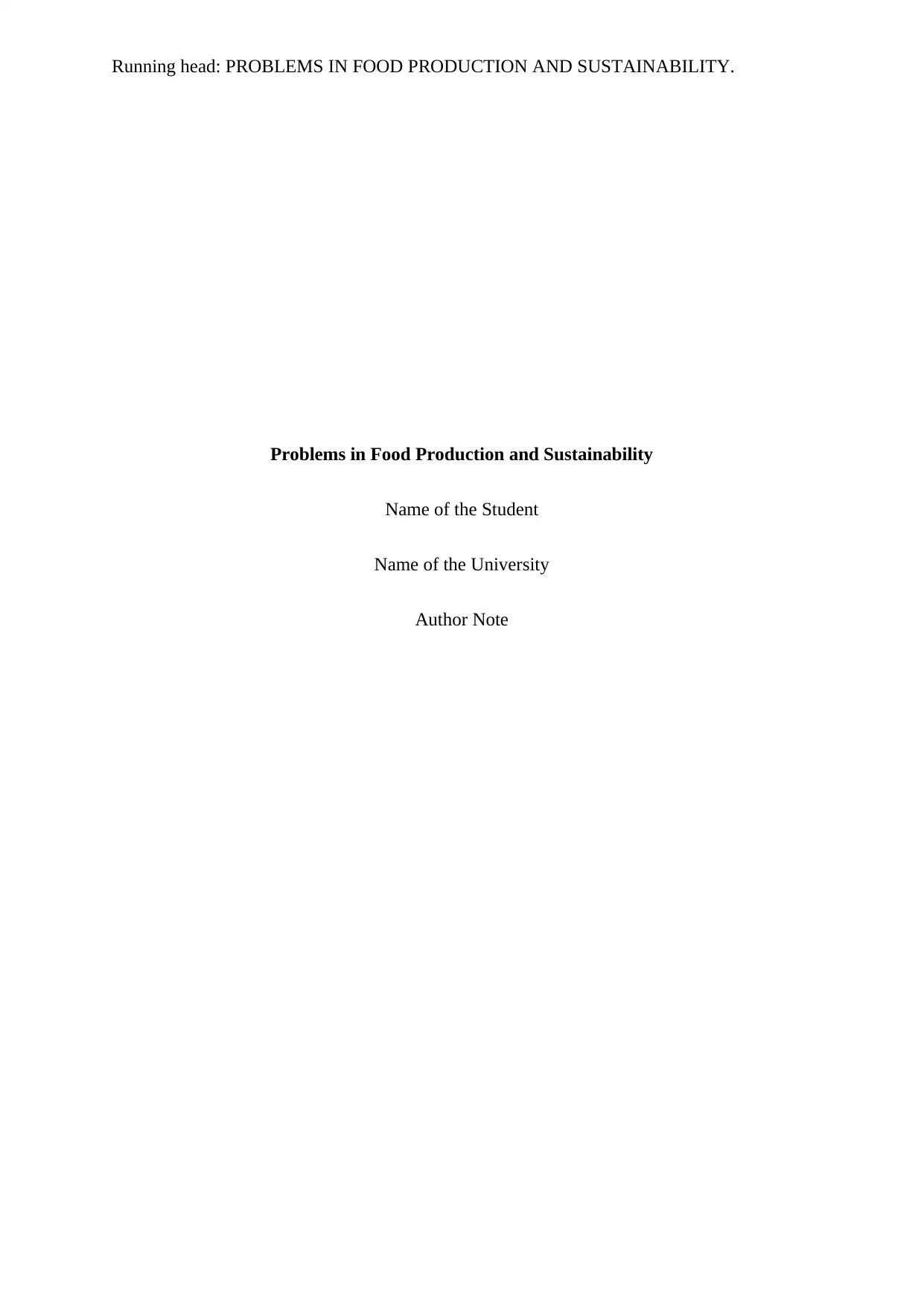
Running head: PROBLEMS IN FOOD PRODUCTION AND SUSTAINABILITY.
Problems in Food Production and Sustainability
Name of the Student
Name of the University
Author Note
Problems in Food Production and Sustainability
Name of the Student
Name of the University
Author Note
Paraphrase This Document
Need a fresh take? Get an instant paraphrase of this document with our AI Paraphraser
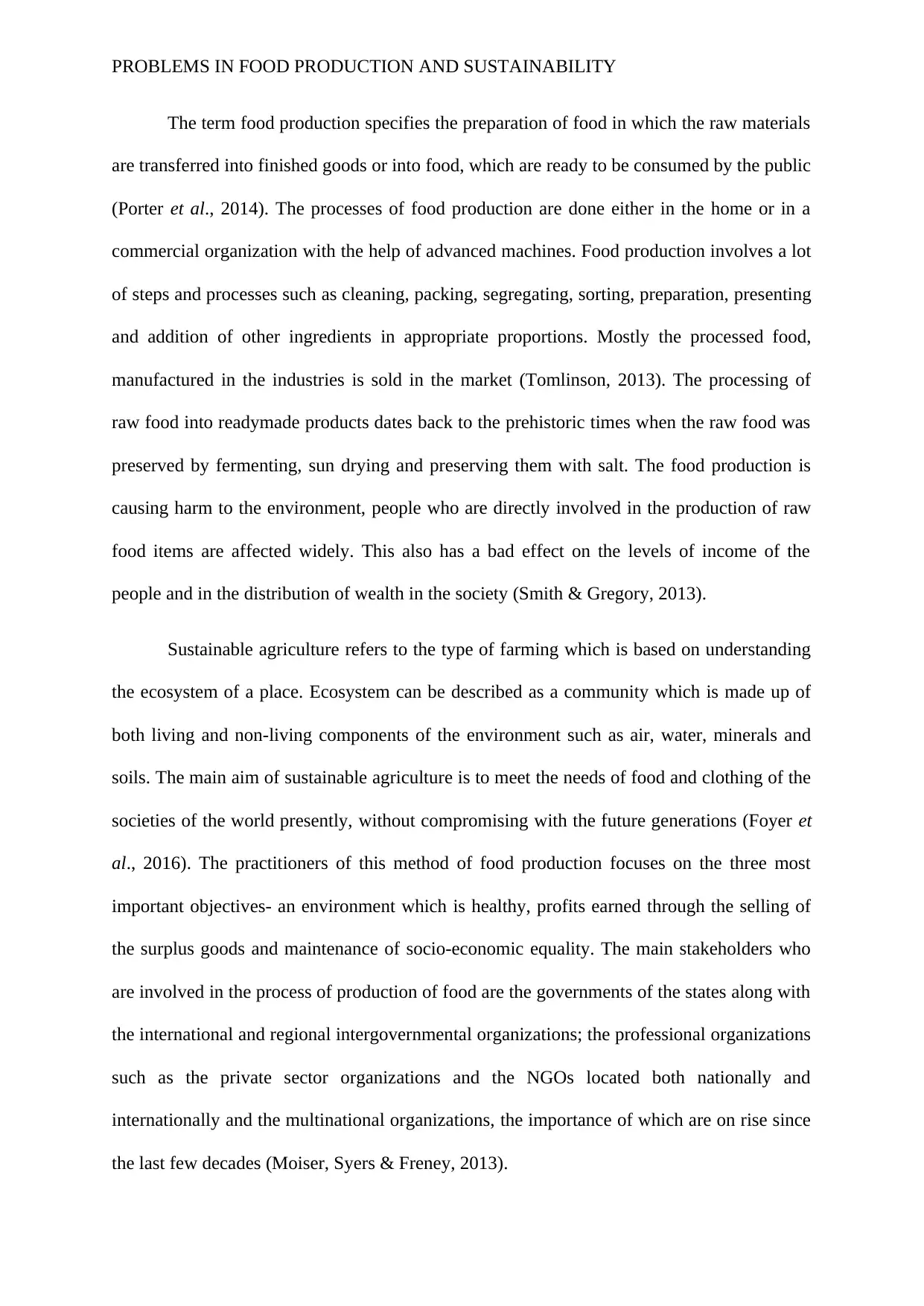
PROBLEMS IN FOOD PRODUCTION AND SUSTAINABILITY
The term food production specifies the preparation of food in which the raw materials
are transferred into finished goods or into food, which are ready to be consumed by the public
(Porter et al., 2014). The processes of food production are done either in the home or in a
commercial organization with the help of advanced machines. Food production involves a lot
of steps and processes such as cleaning, packing, segregating, sorting, preparation, presenting
and addition of other ingredients in appropriate proportions. Mostly the processed food,
manufactured in the industries is sold in the market (Tomlinson, 2013). The processing of
raw food into readymade products dates back to the prehistoric times when the raw food was
preserved by fermenting, sun drying and preserving them with salt. The food production is
causing harm to the environment, people who are directly involved in the production of raw
food items are affected widely. This also has a bad effect on the levels of income of the
people and in the distribution of wealth in the society (Smith & Gregory, 2013).
Sustainable agriculture refers to the type of farming which is based on understanding
the ecosystem of a place. Ecosystem can be described as a community which is made up of
both living and non-living components of the environment such as air, water, minerals and
soils. The main aim of sustainable agriculture is to meet the needs of food and clothing of the
societies of the world presently, without compromising with the future generations (Foyer et
al., 2016). The practitioners of this method of food production focuses on the three most
important objectives- an environment which is healthy, profits earned through the selling of
the surplus goods and maintenance of socio-economic equality. The main stakeholders who
are involved in the process of production of food are the governments of the states along with
the international and regional intergovernmental organizations; the professional organizations
such as the private sector organizations and the NGOs located both nationally and
internationally and the multinational organizations, the importance of which are on rise since
the last few decades (Moiser, Syers & Freney, 2013).
The term food production specifies the preparation of food in which the raw materials
are transferred into finished goods or into food, which are ready to be consumed by the public
(Porter et al., 2014). The processes of food production are done either in the home or in a
commercial organization with the help of advanced machines. Food production involves a lot
of steps and processes such as cleaning, packing, segregating, sorting, preparation, presenting
and addition of other ingredients in appropriate proportions. Mostly the processed food,
manufactured in the industries is sold in the market (Tomlinson, 2013). The processing of
raw food into readymade products dates back to the prehistoric times when the raw food was
preserved by fermenting, sun drying and preserving them with salt. The food production is
causing harm to the environment, people who are directly involved in the production of raw
food items are affected widely. This also has a bad effect on the levels of income of the
people and in the distribution of wealth in the society (Smith & Gregory, 2013).
Sustainable agriculture refers to the type of farming which is based on understanding
the ecosystem of a place. Ecosystem can be described as a community which is made up of
both living and non-living components of the environment such as air, water, minerals and
soils. The main aim of sustainable agriculture is to meet the needs of food and clothing of the
societies of the world presently, without compromising with the future generations (Foyer et
al., 2016). The practitioners of this method of food production focuses on the three most
important objectives- an environment which is healthy, profits earned through the selling of
the surplus goods and maintenance of socio-economic equality. The main stakeholders who
are involved in the process of production of food are the governments of the states along with
the international and regional intergovernmental organizations; the professional organizations
such as the private sector organizations and the NGOs located both nationally and
internationally and the multinational organizations, the importance of which are on rise since
the last few decades (Moiser, Syers & Freney, 2013).
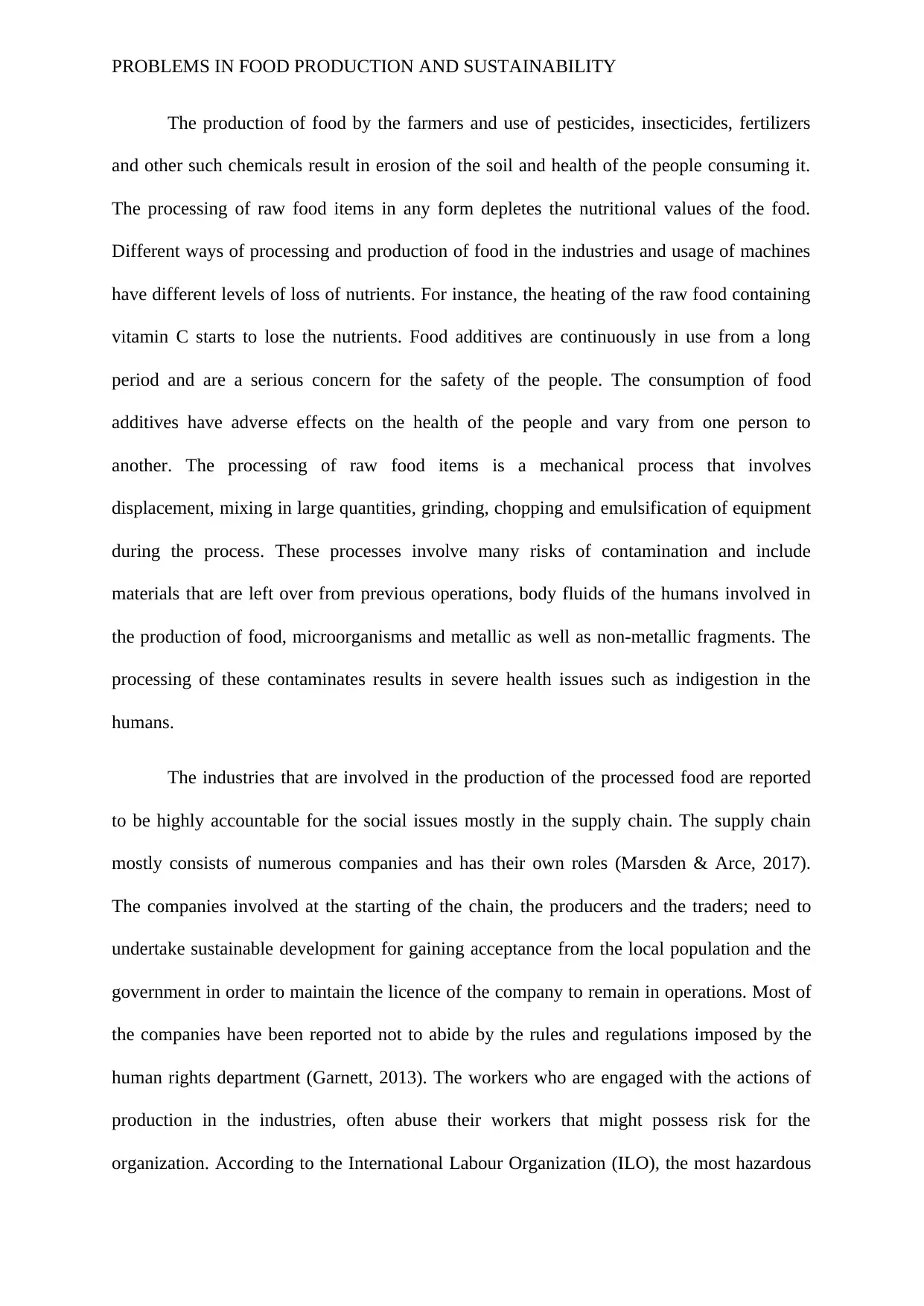
PROBLEMS IN FOOD PRODUCTION AND SUSTAINABILITY
The production of food by the farmers and use of pesticides, insecticides, fertilizers
and other such chemicals result in erosion of the soil and health of the people consuming it.
The processing of raw food items in any form depletes the nutritional values of the food.
Different ways of processing and production of food in the industries and usage of machines
have different levels of loss of nutrients. For instance, the heating of the raw food containing
vitamin C starts to lose the nutrients. Food additives are continuously in use from a long
period and are a serious concern for the safety of the people. The consumption of food
additives have adverse effects on the health of the people and vary from one person to
another. The processing of raw food items is a mechanical process that involves
displacement, mixing in large quantities, grinding, chopping and emulsification of equipment
during the process. These processes involve many risks of contamination and include
materials that are left over from previous operations, body fluids of the humans involved in
the production of food, microorganisms and metallic as well as non-metallic fragments. The
processing of these contaminates results in severe health issues such as indigestion in the
humans.
The industries that are involved in the production of the processed food are reported
to be highly accountable for the social issues mostly in the supply chain. The supply chain
mostly consists of numerous companies and has their own roles (Marsden & Arce, 2017).
The companies involved at the starting of the chain, the producers and the traders; need to
undertake sustainable development for gaining acceptance from the local population and the
government in order to maintain the licence of the company to remain in operations. Most of
the companies have been reported not to abide by the rules and regulations imposed by the
human rights department (Garnett, 2013). The workers who are engaged with the actions of
production in the industries, often abuse their workers that might possess risk for the
organization. According to the International Labour Organization (ILO), the most hazardous
The production of food by the farmers and use of pesticides, insecticides, fertilizers
and other such chemicals result in erosion of the soil and health of the people consuming it.
The processing of raw food items in any form depletes the nutritional values of the food.
Different ways of processing and production of food in the industries and usage of machines
have different levels of loss of nutrients. For instance, the heating of the raw food containing
vitamin C starts to lose the nutrients. Food additives are continuously in use from a long
period and are a serious concern for the safety of the people. The consumption of food
additives have adverse effects on the health of the people and vary from one person to
another. The processing of raw food items is a mechanical process that involves
displacement, mixing in large quantities, grinding, chopping and emulsification of equipment
during the process. These processes involve many risks of contamination and include
materials that are left over from previous operations, body fluids of the humans involved in
the production of food, microorganisms and metallic as well as non-metallic fragments. The
processing of these contaminates results in severe health issues such as indigestion in the
humans.
The industries that are involved in the production of the processed food are reported
to be highly accountable for the social issues mostly in the supply chain. The supply chain
mostly consists of numerous companies and has their own roles (Marsden & Arce, 2017).
The companies involved at the starting of the chain, the producers and the traders; need to
undertake sustainable development for gaining acceptance from the local population and the
government in order to maintain the licence of the company to remain in operations. Most of
the companies have been reported not to abide by the rules and regulations imposed by the
human rights department (Garnett, 2013). The workers who are engaged with the actions of
production in the industries, often abuse their workers that might possess risk for the
organization. According to the International Labour Organization (ILO), the most hazardous
⊘ This is a preview!⊘
Do you want full access?
Subscribe today to unlock all pages.

Trusted by 1+ million students worldwide

PROBLEMS IN FOOD PRODUCTION AND SUSTAINABILITY
occupation that people involve themselves is in the farming. About one third of the
population of the world are involved in the occupation of agriculture, most of them are living
in the third world countries or the developing countries of the world (). The workers working
in the agricultural fields or in the industries require a wage in order to meet their basic needs.
In case of commodity production or agriculture, the farmers do not receive a fixed amount of
wage but they earn their living from the income they are receiving through the sale of the
products.
Though the rate of production of food per person is increasing, countries like sub-
Saharan Africa where the food production per person is reducing recently. The economic
analysis of the production of food required by the people of the world is concerned about the
dynamics of production, income, growth, demand and trade (Liu et al., 2015). Investment of
huge capitals and change in technology especially with the biasness of the saving of the lands
might help in the overcoming of the problem effectively. Certain innovations, which would
be helping in reducing the risk such as stress and introduction of the varieties of crops, might
be more attractive to the farmers. Sustainability of the production of food and risk reduction
techniques through stabilization of price, insuring the crops and contingency plans in order to
relief the crops from the damage caused due to famine, promotion of equality and ensuring of
the market conditions would require actions from the government of the country (Specht et
al., 2014). While there is increase in the supply does not match with the demand of the goods,
many resources would get involved in the production of food as the price of the food rises. As
the supply of food increases, there is a fall in the price of the food and in the income of the
farm and the resources are driven out of the fields of agriculture. The resources might not be
moving at a very fast rate so that they are enough to correct the imbalances. The primary
producers often face deterioration in terms of business (Tukker et al., 2017).
occupation that people involve themselves is in the farming. About one third of the
population of the world are involved in the occupation of agriculture, most of them are living
in the third world countries or the developing countries of the world (). The workers working
in the agricultural fields or in the industries require a wage in order to meet their basic needs.
In case of commodity production or agriculture, the farmers do not receive a fixed amount of
wage but they earn their living from the income they are receiving through the sale of the
products.
Though the rate of production of food per person is increasing, countries like sub-
Saharan Africa where the food production per person is reducing recently. The economic
analysis of the production of food required by the people of the world is concerned about the
dynamics of production, income, growth, demand and trade (Liu et al., 2015). Investment of
huge capitals and change in technology especially with the biasness of the saving of the lands
might help in the overcoming of the problem effectively. Certain innovations, which would
be helping in reducing the risk such as stress and introduction of the varieties of crops, might
be more attractive to the farmers. Sustainability of the production of food and risk reduction
techniques through stabilization of price, insuring the crops and contingency plans in order to
relief the crops from the damage caused due to famine, promotion of equality and ensuring of
the market conditions would require actions from the government of the country (Specht et
al., 2014). While there is increase in the supply does not match with the demand of the goods,
many resources would get involved in the production of food as the price of the food rises. As
the supply of food increases, there is a fall in the price of the food and in the income of the
farm and the resources are driven out of the fields of agriculture. The resources might not be
moving at a very fast rate so that they are enough to correct the imbalances. The primary
producers often face deterioration in terms of business (Tukker et al., 2017).
Paraphrase This Document
Need a fresh take? Get an instant paraphrase of this document with our AI Paraphraser
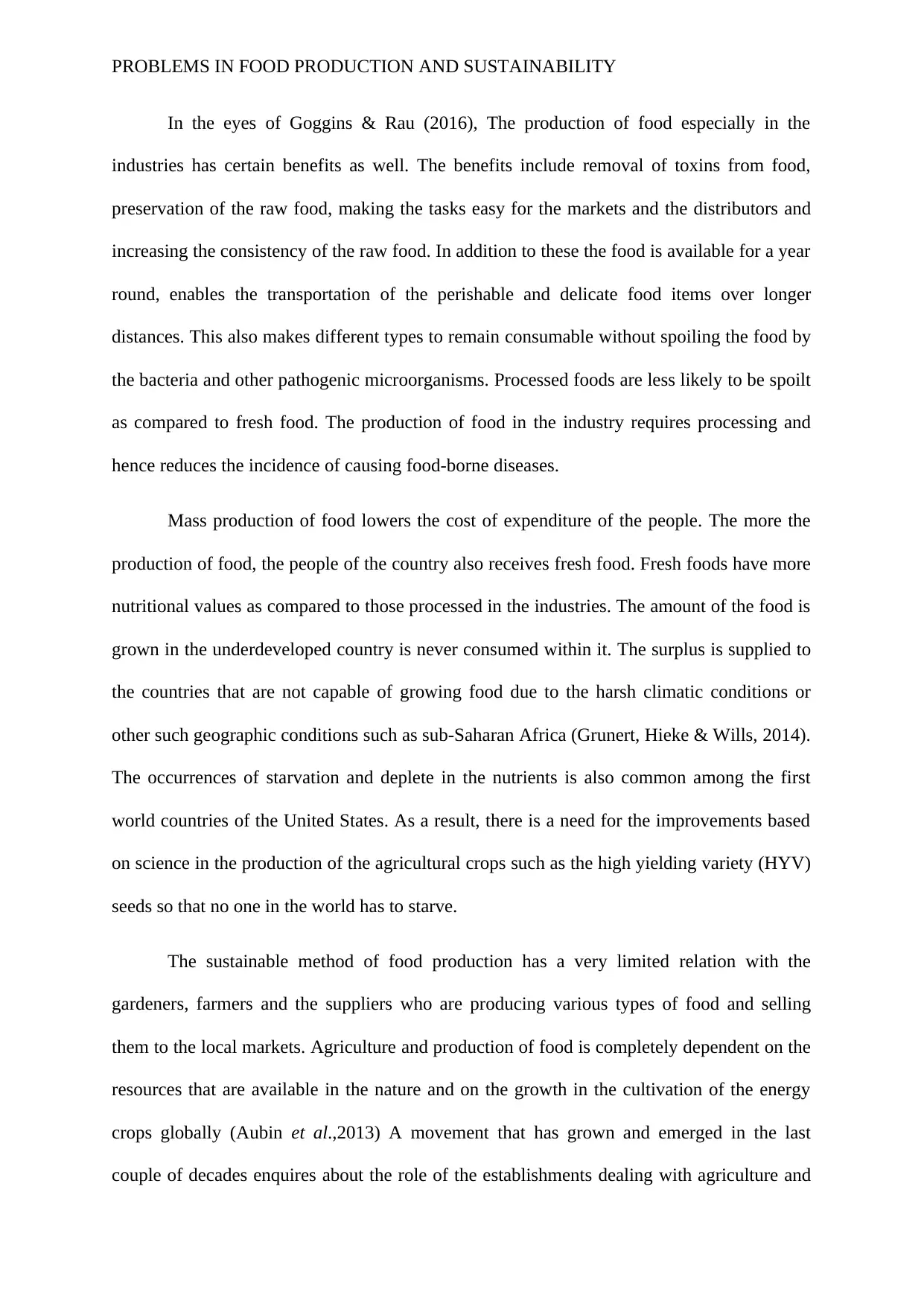
PROBLEMS IN FOOD PRODUCTION AND SUSTAINABILITY
In the eyes of Goggins & Rau (2016), The production of food especially in the
industries has certain benefits as well. The benefits include removal of toxins from food,
preservation of the raw food, making the tasks easy for the markets and the distributors and
increasing the consistency of the raw food. In addition to these the food is available for a year
round, enables the transportation of the perishable and delicate food items over longer
distances. This also makes different types to remain consumable without spoiling the food by
the bacteria and other pathogenic microorganisms. Processed foods are less likely to be spoilt
as compared to fresh food. The production of food in the industry requires processing and
hence reduces the incidence of causing food-borne diseases.
Mass production of food lowers the cost of expenditure of the people. The more the
production of food, the people of the country also receives fresh food. Fresh foods have more
nutritional values as compared to those processed in the industries. The amount of the food is
grown in the underdeveloped country is never consumed within it. The surplus is supplied to
the countries that are not capable of growing food due to the harsh climatic conditions or
other such geographic conditions such as sub-Saharan Africa (Grunert, Hieke & Wills, 2014).
The occurrences of starvation and deplete in the nutrients is also common among the first
world countries of the United States. As a result, there is a need for the improvements based
on science in the production of the agricultural crops such as the high yielding variety (HYV)
seeds so that no one in the world has to starve.
The sustainable method of food production has a very limited relation with the
gardeners, farmers and the suppliers who are producing various types of food and selling
them to the local markets. Agriculture and production of food is completely dependent on the
resources that are available in the nature and on the growth in the cultivation of the energy
crops globally (Aubin et al.,2013) A movement that has grown and emerged in the last
couple of decades enquires about the role of the establishments dealing with agriculture and
In the eyes of Goggins & Rau (2016), The production of food especially in the
industries has certain benefits as well. The benefits include removal of toxins from food,
preservation of the raw food, making the tasks easy for the markets and the distributors and
increasing the consistency of the raw food. In addition to these the food is available for a year
round, enables the transportation of the perishable and delicate food items over longer
distances. This also makes different types to remain consumable without spoiling the food by
the bacteria and other pathogenic microorganisms. Processed foods are less likely to be spoilt
as compared to fresh food. The production of food in the industry requires processing and
hence reduces the incidence of causing food-borne diseases.
Mass production of food lowers the cost of expenditure of the people. The more the
production of food, the people of the country also receives fresh food. Fresh foods have more
nutritional values as compared to those processed in the industries. The amount of the food is
grown in the underdeveloped country is never consumed within it. The surplus is supplied to
the countries that are not capable of growing food due to the harsh climatic conditions or
other such geographic conditions such as sub-Saharan Africa (Grunert, Hieke & Wills, 2014).
The occurrences of starvation and deplete in the nutrients is also common among the first
world countries of the United States. As a result, there is a need for the improvements based
on science in the production of the agricultural crops such as the high yielding variety (HYV)
seeds so that no one in the world has to starve.
The sustainable method of food production has a very limited relation with the
gardeners, farmers and the suppliers who are producing various types of food and selling
them to the local markets. Agriculture and production of food is completely dependent on the
resources that are available in the nature and on the growth in the cultivation of the energy
crops globally (Aubin et al.,2013) A movement that has grown and emerged in the last
couple of decades enquires about the role of the establishments dealing with agriculture and
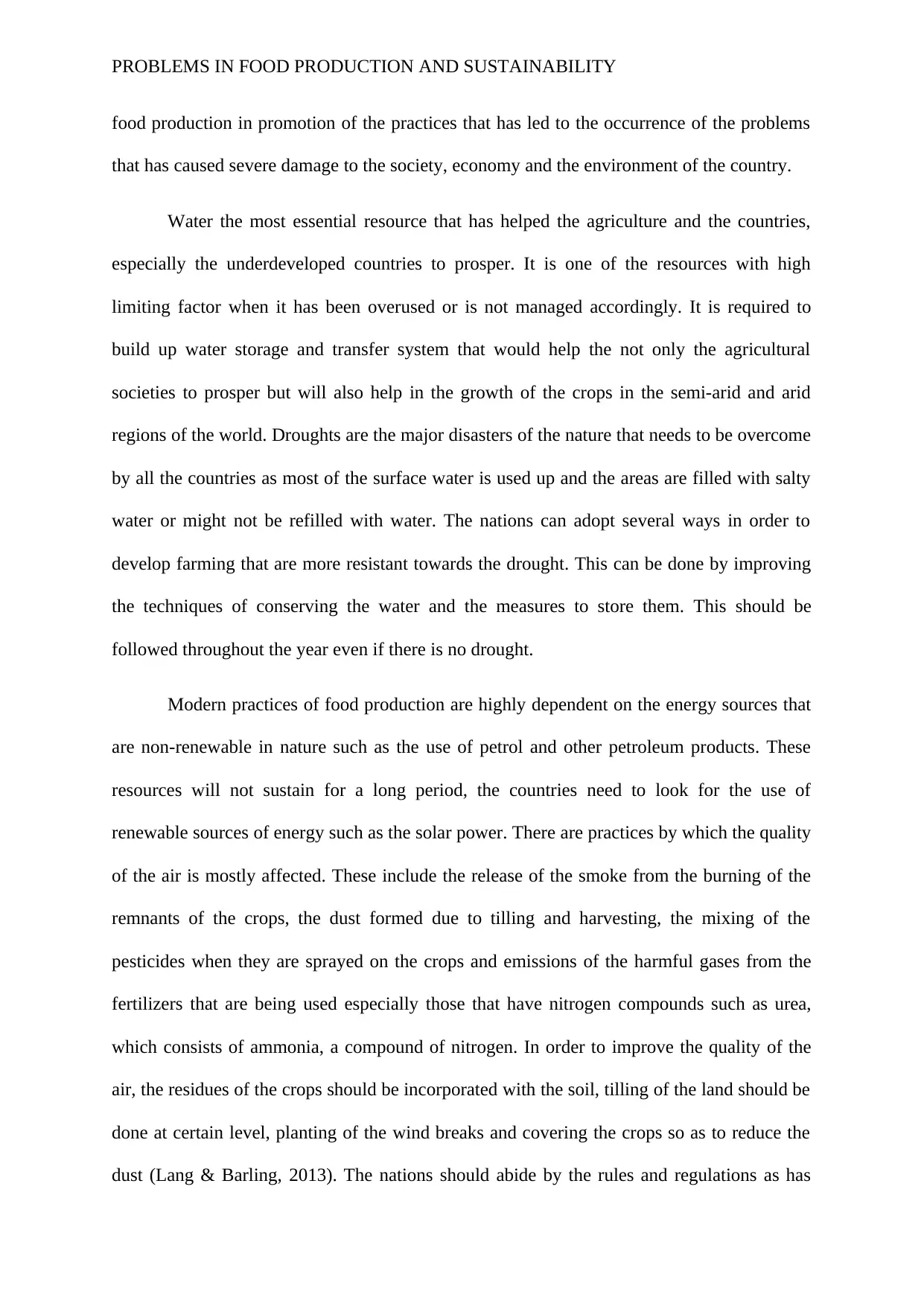
PROBLEMS IN FOOD PRODUCTION AND SUSTAINABILITY
food production in promotion of the practices that has led to the occurrence of the problems
that has caused severe damage to the society, economy and the environment of the country.
Water the most essential resource that has helped the agriculture and the countries,
especially the underdeveloped countries to prosper. It is one of the resources with high
limiting factor when it has been overused or is not managed accordingly. It is required to
build up water storage and transfer system that would help the not only the agricultural
societies to prosper but will also help in the growth of the crops in the semi-arid and arid
regions of the world. Droughts are the major disasters of the nature that needs to be overcome
by all the countries as most of the surface water is used up and the areas are filled with salty
water or might not be refilled with water. The nations can adopt several ways in order to
develop farming that are more resistant towards the drought. This can be done by improving
the techniques of conserving the water and the measures to store them. This should be
followed throughout the year even if there is no drought.
Modern practices of food production are highly dependent on the energy sources that
are non-renewable in nature such as the use of petrol and other petroleum products. These
resources will not sustain for a long period, the countries need to look for the use of
renewable sources of energy such as the solar power. There are practices by which the quality
of the air is mostly affected. These include the release of the smoke from the burning of the
remnants of the crops, the dust formed due to tilling and harvesting, the mixing of the
pesticides when they are sprayed on the crops and emissions of the harmful gases from the
fertilizers that are being used especially those that have nitrogen compounds such as urea,
which consists of ammonia, a compound of nitrogen. In order to improve the quality of the
air, the residues of the crops should be incorporated with the soil, tilling of the land should be
done at certain level, planting of the wind breaks and covering the crops so as to reduce the
dust (Lang & Barling, 2013). The nations should abide by the rules and regulations as has
food production in promotion of the practices that has led to the occurrence of the problems
that has caused severe damage to the society, economy and the environment of the country.
Water the most essential resource that has helped the agriculture and the countries,
especially the underdeveloped countries to prosper. It is one of the resources with high
limiting factor when it has been overused or is not managed accordingly. It is required to
build up water storage and transfer system that would help the not only the agricultural
societies to prosper but will also help in the growth of the crops in the semi-arid and arid
regions of the world. Droughts are the major disasters of the nature that needs to be overcome
by all the countries as most of the surface water is used up and the areas are filled with salty
water or might not be refilled with water. The nations can adopt several ways in order to
develop farming that are more resistant towards the drought. This can be done by improving
the techniques of conserving the water and the measures to store them. This should be
followed throughout the year even if there is no drought.
Modern practices of food production are highly dependent on the energy sources that
are non-renewable in nature such as the use of petrol and other petroleum products. These
resources will not sustain for a long period, the countries need to look for the use of
renewable sources of energy such as the solar power. There are practices by which the quality
of the air is mostly affected. These include the release of the smoke from the burning of the
remnants of the crops, the dust formed due to tilling and harvesting, the mixing of the
pesticides when they are sprayed on the crops and emissions of the harmful gases from the
fertilizers that are being used especially those that have nitrogen compounds such as urea,
which consists of ammonia, a compound of nitrogen. In order to improve the quality of the
air, the residues of the crops should be incorporated with the soil, tilling of the land should be
done at certain level, planting of the wind breaks and covering the crops so as to reduce the
dust (Lang & Barling, 2013). The nations should abide by the rules and regulations as has
⊘ This is a preview!⊘
Do you want full access?
Subscribe today to unlock all pages.

Trusted by 1+ million students worldwide
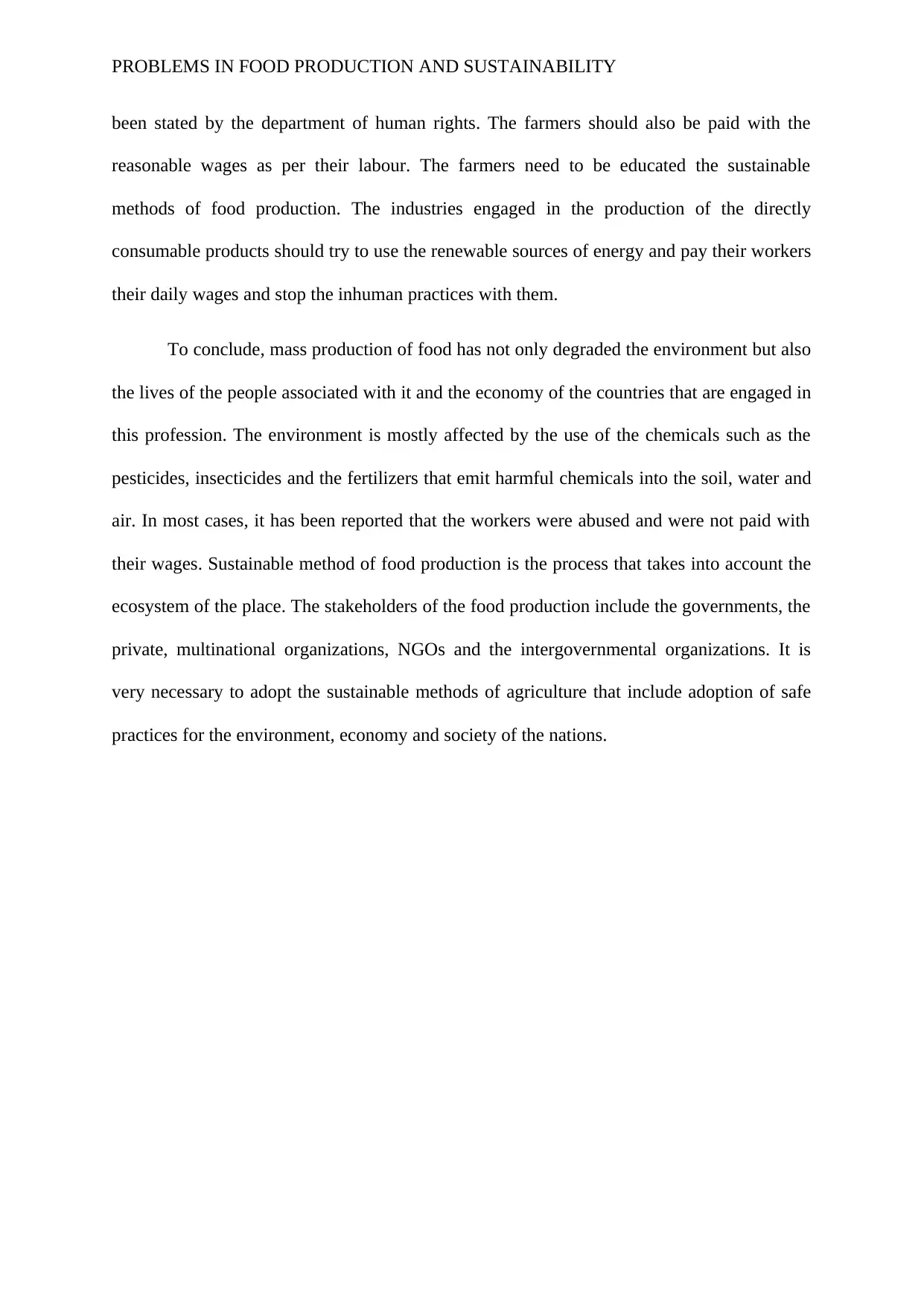
PROBLEMS IN FOOD PRODUCTION AND SUSTAINABILITY
been stated by the department of human rights. The farmers should also be paid with the
reasonable wages as per their labour. The farmers need to be educated the sustainable
methods of food production. The industries engaged in the production of the directly
consumable products should try to use the renewable sources of energy and pay their workers
their daily wages and stop the inhuman practices with them.
To conclude, mass production of food has not only degraded the environment but also
the lives of the people associated with it and the economy of the countries that are engaged in
this profession. The environment is mostly affected by the use of the chemicals such as the
pesticides, insecticides and the fertilizers that emit harmful chemicals into the soil, water and
air. In most cases, it has been reported that the workers were abused and were not paid with
their wages. Sustainable method of food production is the process that takes into account the
ecosystem of the place. The stakeholders of the food production include the governments, the
private, multinational organizations, NGOs and the intergovernmental organizations. It is
very necessary to adopt the sustainable methods of agriculture that include adoption of safe
practices for the environment, economy and society of the nations.
been stated by the department of human rights. The farmers should also be paid with the
reasonable wages as per their labour. The farmers need to be educated the sustainable
methods of food production. The industries engaged in the production of the directly
consumable products should try to use the renewable sources of energy and pay their workers
their daily wages and stop the inhuman practices with them.
To conclude, mass production of food has not only degraded the environment but also
the lives of the people associated with it and the economy of the countries that are engaged in
this profession. The environment is mostly affected by the use of the chemicals such as the
pesticides, insecticides and the fertilizers that emit harmful chemicals into the soil, water and
air. In most cases, it has been reported that the workers were abused and were not paid with
their wages. Sustainable method of food production is the process that takes into account the
ecosystem of the place. The stakeholders of the food production include the governments, the
private, multinational organizations, NGOs and the intergovernmental organizations. It is
very necessary to adopt the sustainable methods of agriculture that include adoption of safe
practices for the environment, economy and society of the nations.
Paraphrase This Document
Need a fresh take? Get an instant paraphrase of this document with our AI Paraphraser

PROBLEMS IN FOOD PRODUCTION AND SUSTAINABILITY
References
Aubin, J., Donnars, C., Supkova, M., Dorin, B., Gaillard, G., Garcia, F., ... & Lemeilleur, S.
(2013). A critical panorama of methods used to assess food sustainability.
Foyer, C. H., Lam, H. M., Nguyen, H. T., Siddique, K. H., Varshney, R. K., Colmer, T. D., ...
& Cooper, J. W. (2016). Neglecting legumes has compromised human health and
sustainable food production. Nature plants, 2(8), 16112.
Garnett, T. (2013). Food sustainability: problems, perspectives and solutions. Proceedings of
the Nutrition Society, 72(1), 29-39.
Goggins, G., & Rau, H. (2016). Beyond calorie counting: Assessing the sustainability of food
provided for public consumption. Journal of Cleaner Production, 112, 257-266.
Grunert, K. G., Hieke, S., & Wills, J. (2014). Sustainability labels on food products:
Consumer motivation, understanding and use. Food Policy, 44, 177-189.
Lang, T., & Barling, D. (2013). Nutrition and sustainability: an emerging food policy
discourse. Proceedings of the Nutrition Society, 72(1), 1-12
Liu, J., Mooney, H., Hull, V., Davis, S. J., Gaskell, J., Hertel, T., ... & Li, S. (2015). Systems
integration for global sustainability. Science, 347(6225), 1258832.
Marsden, T. K., & Arce, A. (2017). The social construction of international food: a new
research agenda. In The Rural(pp. 87-106). Routledge.
Martindale, W. (2014). Using consumer surveys to determine food sustainability. British
Food Journal, 116(7), 1194-1204.
References
Aubin, J., Donnars, C., Supkova, M., Dorin, B., Gaillard, G., Garcia, F., ... & Lemeilleur, S.
(2013). A critical panorama of methods used to assess food sustainability.
Foyer, C. H., Lam, H. M., Nguyen, H. T., Siddique, K. H., Varshney, R. K., Colmer, T. D., ...
& Cooper, J. W. (2016). Neglecting legumes has compromised human health and
sustainable food production. Nature plants, 2(8), 16112.
Garnett, T. (2013). Food sustainability: problems, perspectives and solutions. Proceedings of
the Nutrition Society, 72(1), 29-39.
Goggins, G., & Rau, H. (2016). Beyond calorie counting: Assessing the sustainability of food
provided for public consumption. Journal of Cleaner Production, 112, 257-266.
Grunert, K. G., Hieke, S., & Wills, J. (2014). Sustainability labels on food products:
Consumer motivation, understanding and use. Food Policy, 44, 177-189.
Lang, T., & Barling, D. (2013). Nutrition and sustainability: an emerging food policy
discourse. Proceedings of the Nutrition Society, 72(1), 1-12
Liu, J., Mooney, H., Hull, V., Davis, S. J., Gaskell, J., Hertel, T., ... & Li, S. (2015). Systems
integration for global sustainability. Science, 347(6225), 1258832.
Marsden, T. K., & Arce, A. (2017). The social construction of international food: a new
research agenda. In The Rural(pp. 87-106). Routledge.
Martindale, W. (2014). Using consumer surveys to determine food sustainability. British
Food Journal, 116(7), 1194-1204.
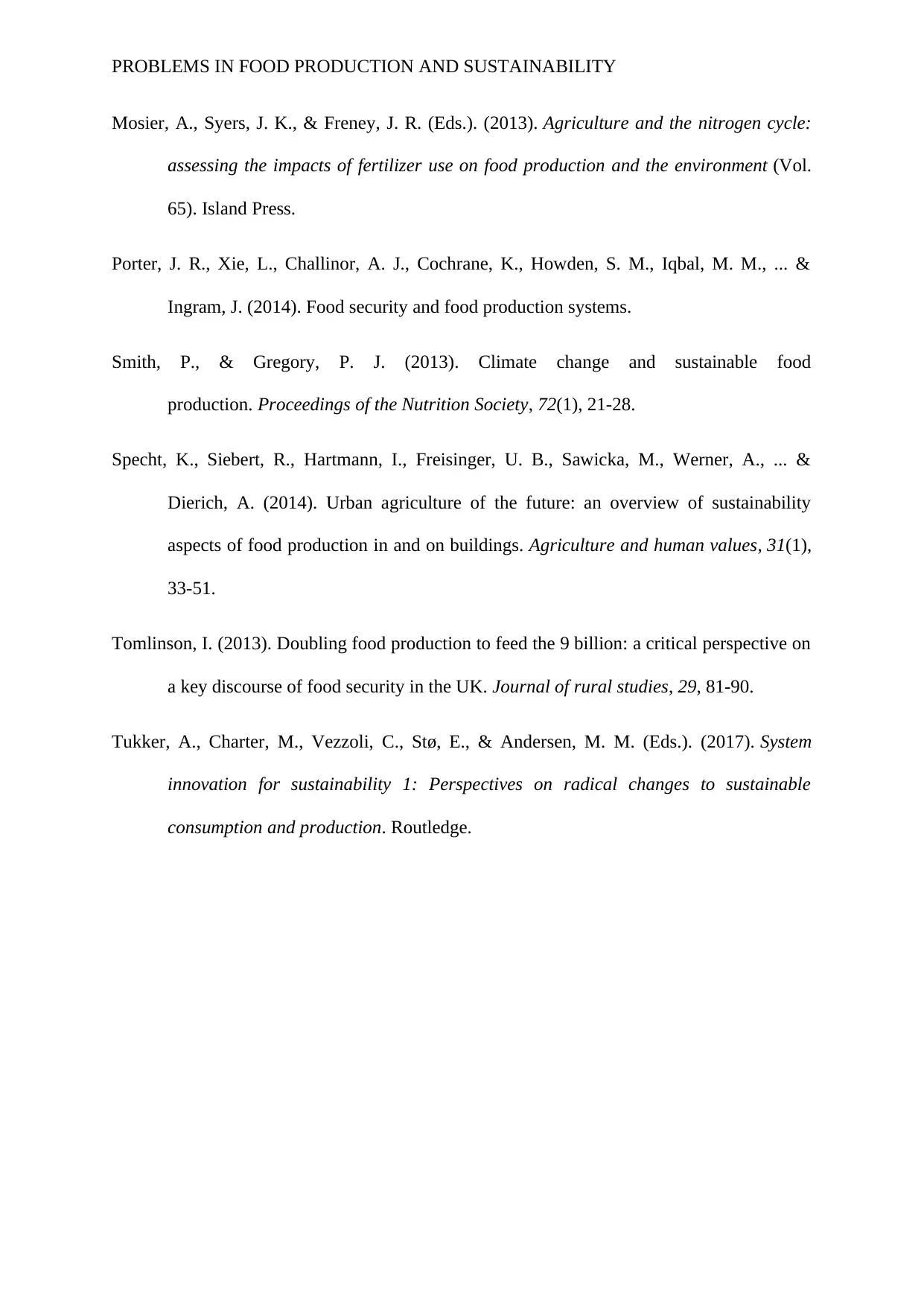
PROBLEMS IN FOOD PRODUCTION AND SUSTAINABILITY
Mosier, A., Syers, J. K., & Freney, J. R. (Eds.). (2013). Agriculture and the nitrogen cycle:
assessing the impacts of fertilizer use on food production and the environment (Vol.
65). Island Press.
Porter, J. R., Xie, L., Challinor, A. J., Cochrane, K., Howden, S. M., Iqbal, M. M., ... &
Ingram, J. (2014). Food security and food production systems.
Smith, P., & Gregory, P. J. (2013). Climate change and sustainable food
production. Proceedings of the Nutrition Society, 72(1), 21-28.
Specht, K., Siebert, R., Hartmann, I., Freisinger, U. B., Sawicka, M., Werner, A., ... &
Dierich, A. (2014). Urban agriculture of the future: an overview of sustainability
aspects of food production in and on buildings. Agriculture and human values, 31(1),
33-51.
Tomlinson, I. (2013). Doubling food production to feed the 9 billion: a critical perspective on
a key discourse of food security in the UK. Journal of rural studies, 29, 81-90.
Tukker, A., Charter, M., Vezzoli, C., Stø, E., & Andersen, M. M. (Eds.). (2017). System
innovation for sustainability 1: Perspectives on radical changes to sustainable
consumption and production. Routledge.
Mosier, A., Syers, J. K., & Freney, J. R. (Eds.). (2013). Agriculture and the nitrogen cycle:
assessing the impacts of fertilizer use on food production and the environment (Vol.
65). Island Press.
Porter, J. R., Xie, L., Challinor, A. J., Cochrane, K., Howden, S. M., Iqbal, M. M., ... &
Ingram, J. (2014). Food security and food production systems.
Smith, P., & Gregory, P. J. (2013). Climate change and sustainable food
production. Proceedings of the Nutrition Society, 72(1), 21-28.
Specht, K., Siebert, R., Hartmann, I., Freisinger, U. B., Sawicka, M., Werner, A., ... &
Dierich, A. (2014). Urban agriculture of the future: an overview of sustainability
aspects of food production in and on buildings. Agriculture and human values, 31(1),
33-51.
Tomlinson, I. (2013). Doubling food production to feed the 9 billion: a critical perspective on
a key discourse of food security in the UK. Journal of rural studies, 29, 81-90.
Tukker, A., Charter, M., Vezzoli, C., Stø, E., & Andersen, M. M. (Eds.). (2017). System
innovation for sustainability 1: Perspectives on radical changes to sustainable
consumption and production. Routledge.
⊘ This is a preview!⊘
Do you want full access?
Subscribe today to unlock all pages.

Trusted by 1+ million students worldwide
1 out of 9
Related Documents
Your All-in-One AI-Powered Toolkit for Academic Success.
+13062052269
info@desklib.com
Available 24*7 on WhatsApp / Email
![[object Object]](/_next/static/media/star-bottom.7253800d.svg)
Unlock your academic potential
Copyright © 2020–2025 A2Z Services. All Rights Reserved. Developed and managed by ZUCOL.





